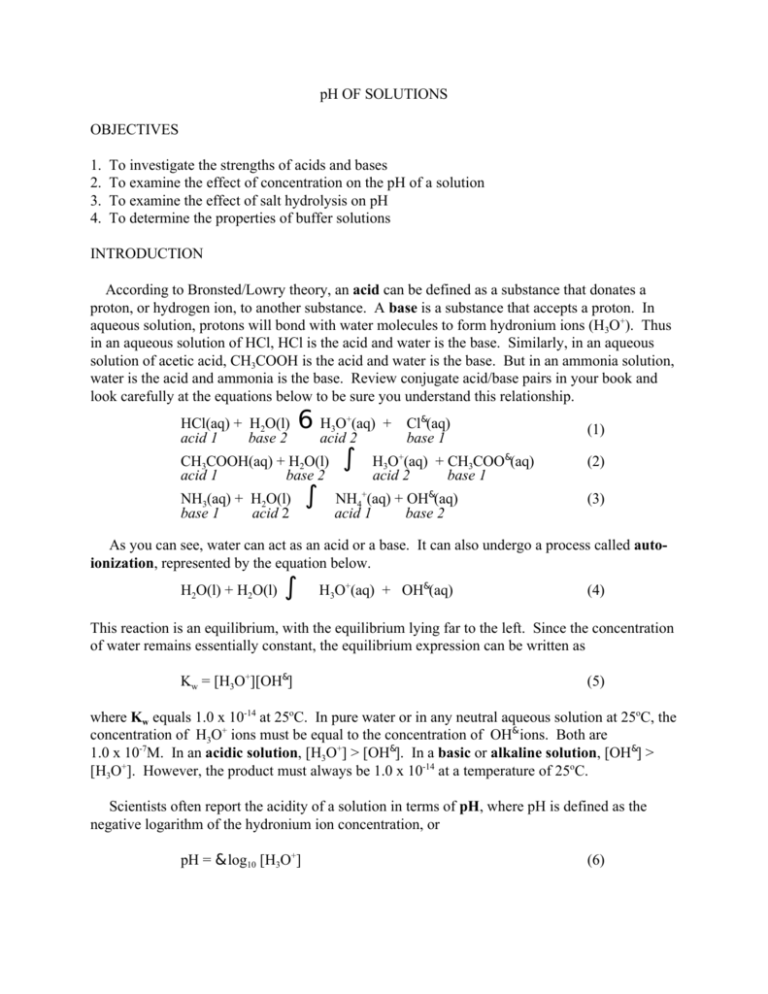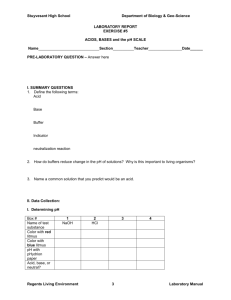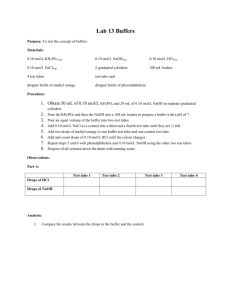pH of Solutions
advertisement

pH OF SOLUTIONS OBJECTIVES 1. 2. 3. 4. To investigate the strengths of acids and bases To examine the effect of concentration on the pH of a solution To examine the effect of salt hydrolysis on pH To determine the properties of buffer solutions INTRODUCTION According to Bronsted/Lowry theory, an acid can be defined as a substance that donates a proton, or hydrogen ion, to another substance. A base is a substance that accepts a proton. In aqueous solution, protons will bond with water molecules to form hydronium ions (H3O+). Thus in an aqueous solution of HCl, HCl is the acid and water is the base. Similarly, in an aqueous solution of acetic acid, CH3COOH is the acid and water is the base. But in an ammonia solution, water is the acid and ammonia is the base. Review conjugate acid/base pairs in your book and look carefully at the equations below to be sure you understand this relationship. 6 H O (aq) + Cl (aq) acid 2 base 1 CH COOH(aq) + H O(l) º H O (aq) + CH COO (aq) acid 1 base 2 acid 2 base 1 NH (aq) + H O(l) º NH (aq) + OH (aq) & + HCl(aq) + H2O(l) acid 1 base 2 3 & + 3 2 3 + 3 base 1 2 acid 2 4 acid 1 3 & (1) (2) (3) base 2 As you can see, water can act as an acid or a base. It can also undergo a process called autoionization, represented by the equation below. H2O(l) + H2O(l) º H3O+(aq) + OH&(aq) (4) This reaction is an equilibrium, with the equilibrium lying far to the left. Since the concentration of water remains essentially constant, the equilibrium expression can be written as Kw = [H3O+][OH&] (5) where Kw equals 1.0 x 10-14 at 25oC. In pure water or in any neutral aqueous solution at 25oC, the concentration of H3O+ ions must be equal to the concentration of OH& ions. Both are 1.0 x 10-7M. In an acidic solution, [H3O+] > [OH&]. In a basic or alkaline solution, [OH&] > [H3O+]. However, the product must always be 1.0 x 10-14 at a temperature of 25oC. Scientists often report the acidity of a solution in terms of pH, where pH is defined as the negative logarithm of the hydronium ion concentration, or pH = & log10 [H3O+] (6) For any neutral solution, pH = & log (1.0 x 10-7M) = 7.0. Thus in an acidic solution, the pH must be less than 7, while a basic solution must have a pH greater than 7. A lower pH indicates a greater concentration of hydronium ions and a more acidic solution; a higher pH indicates a lower concentration of hydronium, a greater concentration of hydroxide, and thus a more basic solution. Part I. Strength of acids and bases Acids are defined as strong or weak depending on their extent of ionization in aqueous solution. Strong acids ionize essentially completely in dilute solution to form H3O+ ions; weak acids ionize only slightly. Look again at equations (1) and (2). Notice that the arrow is shown going in only one direction for the HCl reaction, indicating extensive ionization; however, the reaction between acetic acid and water is reversible. Thus HCl ionizes essentially completely while acetic acid ionizes to a much smaller extent. This difference in ionization will be reflected in a difference in pH. Base strength is defined in a similar manner. Strong bases such as NaOH extensively dissociate in solution, forming hydroxide ions. NaOH (aq) 6 Na+(aq) + OH&(aq) (7) Weaker bases, such as ammonia, ionize only slightly and produce a lower concentration of hydroxide ions, as shown in equation (3). Part II. Concentration and pH If the concentration of an acid or base in solution is changed, the concentration of hydronium ions and hydroxide ions will also change. For example, if the concentration of hydronium ions increases, hydroxide ion concentration must decrease to maintain the equilibrium shown in equation (4). This will be reflected in a change in the pH of the solution. Part III. Salt hydrolysis Salts are formed from the reaction of an acid with a base. A salt consists of a cation (which is the conjugate acid of the base that reacted) and an anion (which is the conjugate base of the acid that reacted). Solutions of some salts are neutral, but other salts will react with water in what is known as a hydrolysis reaction. When this happens, the salt solution will not have a pH of 7. We can identify different categories of salts, based on the strength of the corresponding acids and bases: 1. A salt formed from reaction of a strong base and a strong acid should give a neutral solution. For example, KBr is formed from the reaction of KOH, a strong base, and HBr, a strong acid. Neither the potassium ion nor the bromide ion can undergo a hydrolysis reaction, so a potassium bromide solution should be neutral. (NOTE: Often solutions of pure water or neutral salts are slightly acidic, due to the formation of carbonic acid from the reaction of carbon dioxide from the air with water.) CO2 (g) + H2O(l) W H CO (aq) W H (aq) + HCO G + 2 3 3 (aq) (8) 2. A salt formed from reaction of a weak base and a strong acid should give an acidic solution. For example, NH4Cl is formed from the reaction of NH3, a weak base, and HCl, a strong acid. The chloride ion will not hydrolyze. However, the ammonium ion is the conjugate acid of NH3 and will react with water, producing hydronium ions. NH4+(aq) + H2O(l) W NH (aq) + H O (aq) + 3 3 (9) 3. A salt formed from reaction of a strong base and a weak acid should give a basic solution. An example is NaF, which can be formed from the reaction of NaOH, a strong base, and HF, a weak acid. In this case the sodium ion will not hydrolyze, but the fluoride ion will. Fluoride is the conjugate base of HF and produces hydroxide ions in solution. W HF(aq) + OH (aq) FG(aq) + H2O(l) G (10) Part IV. Buffers Solutions that contain a mixture of a weak acid and its salt or a weak base and its salt are called buffers. Buffer solutions resist changes in pH when small amounts of acids or bases are added. Thus they must be able to react with both H+ from added acid and OHG from added base. A solution containing both formic acid (HCOOH) and its salt, sodium formate (NaHCOO), would be a buffer. The formate ion is the conjugate base of formic acid. Any added acid reacts with the formate as follows: HCOOG + H+ W HCOOH (11) Added base will react with the formic acid: HCOOH + OHG W HCOO G + H2O These reactions enable the buffered system to maintain a fairly constant pH. (12) PROCEDURE You should obtain 6 test tubes from the instructor. Clean them thoroughly and rinse well with distilled water as needed for the remaining parts of this lab. Prepare each tube and then measure its pH using pH paper. Record pH on the laboratory report sheet. NOTE: Before you discard the contents of any tube, check to see whether it is needed for the next section. Part I. Strength of acids and bases Tube 1: Tube 2: Tube 3: Tube 4: 2 mL of 0.10M HCl (Volume can be approximated for this section.) 2 mL of 0.10M acetic acid 2 mL of 0.10M NaOH 2 mL of 0.10M NH3 Part II. Concentration and pH Tube 5: Tube 6: Tube 7: Tube 8: 1 mL of 0.10M HCl from tube 1 thoroughly mixed with 9 mL distilled water 1 mL of the solution from tube 5 thoroughly mixed with 9 mL distilled water 1 mL of 0.10M NaOH from tube 3 thoroughly mixed with 9 mL distilled water 1 mL of the solution from tube 7 thoroughly mixed with 9 mL distilled water Part III. Salt hydrolysis Tube 9: Tube 10: Tube 11: Tube 12: 2 mL of 0.10M NaCl (Volume can be approximated for this section.) 2 mL of 0.10M NaCH3COO 2 mL of 0.10M NaNO3 2 mL of 0.10 M NH4Cl Part IV. Buffers Tube 13: 2 mL of 0.20M CH3COOH thoroughly mixed with 2 mL of 0.20M NaCH3COO After you have measured the pH of tube 13, divide its contents equally between 2 tubes. These will now be tubes 14 and 15. Tube 16: 2 mL of 0.20M NH3 thoroughly mixed with 2 mL of 0.20M NH4Cl After you have measured the pH of tube 16, divide its contents equally between 2 tubes. These will now be tubes 17 and 18. Tube 19: Tube 20: 2 mL distilled water 2 mL distilled water Arrange tubes 14, 17, and 19 in a rack. To each, add 2 drops of 0.10M HCl. Mix thoroughly and record the pH. Add 2 more drops of the HCl; mix and record the pH. Continue the addition as described until you have added a total of ten drops. Arrange tubes 15, 18, and 20 in a rack. To each, add 2 drops of 0.10 M NaOH. Mix thoroughly and record the pH. Add 2 more drops of the NaOH; mix and record the pH. Continue the addition as described until you have added a total of ten drops. pH OF SOLUTIONS LABORATORY REPORT NAME DATE_____________________________ Part I. Strength of acids and bases TUBE # TUBE CONTENTS 1 HCl 2 CH3COOH 3 NaOH 4 NH3 MEASURED pH Part II. Concentration and pH Calculate the concentration of HCl or NaOH in each tube and record along with the measured pH. Show your work in the space provided below. Note: Since you are doing a dilution, you may use M1V1 = M2V2 for your calculation. TUBE # TUBE CONTENTS 5 HCl 6 HCl 7 NaOH 8 NaOH CONCENTRATION Part III. Salt hydrolysis TUBE # TUBE CONTENTS 9 NaCl 10 NaCH3COO 11 NaNO3 12 NH4Cl MEASURED pH MEASURED pH Part IV. Buffers Calculate the concentrations in each tube after mixing and record along with the measured pH. Show your work in the space provided below. TUBE # CONTENTS 13 CH3COOH NaCH3COO 16 NH3 NH4Cl TUBE # CONTENTS 14 CH3COOH NaCH3COO 17 NH3 NH4Cl 19 Water TUBE # CONTENTS 15 CH3COOH NaCH3COO 18 NH3 NH4Cl 20 Water CONCENTRATIONS MEASURED pH MEASURED pH AFTER ADDING HCl 2 drops 4 drops 6 drops 8 drops 10 drops MEASURED pH AFTER ADDING NaOH 2 drops 4 drops 6 drops 8 drops 10 drops QUESTIONS Part I. 1. Why is the pH of 0.10 M acetic acid not the same as the pH of 0.10 M HCl? 2. Which solution has the higher pH, 0.10 M NaOH or 0.10 M NH3? Is this the result you expected? Why or why not? Part II. 3. Compare your results for tubes 1, 5, and 6. What is the relationship between the concentration of HCl and the pH? 4. Compare your results for tubes 3, 7, and 8. What is the relationship between the concentration of NaOH and pH? Is this what you expected? Explain. Part III. 5. Which salt(s) would you expect to give a neutral solution? Why? If you expected a neutral solution and it was not observed, provide an explanation. 6. Which salt(s) would you expect to give an acidic solution? What salt(s) would you expect to give a basic solution? Why? Is this what you observed? Part IV. 7. Focus on tubes 13, 14, and 15. What happens to the pH of the solution as HCl is added? As NaOH is added? Is this solution acting as a buffer system? Explain. 8. Focus on tubes 14, 17, and 19. Which system does the best job of acting as a buffer when HCl is added? Which system does the worst job? 9. Focus on tubes 15, 18, and 20. Which system is NOT acting as a buffer against added NaOH? 10. Combine the information gathered from the acetic acid/sodium acetate buffer system into a graph, with pH on the y-axis and # drops HCl or NaOH added on the x-axis. Do the same with the information from the ammonia/ammonium chloride system and with the information from water. What distinguishes the buffer graphs from the water graph?






